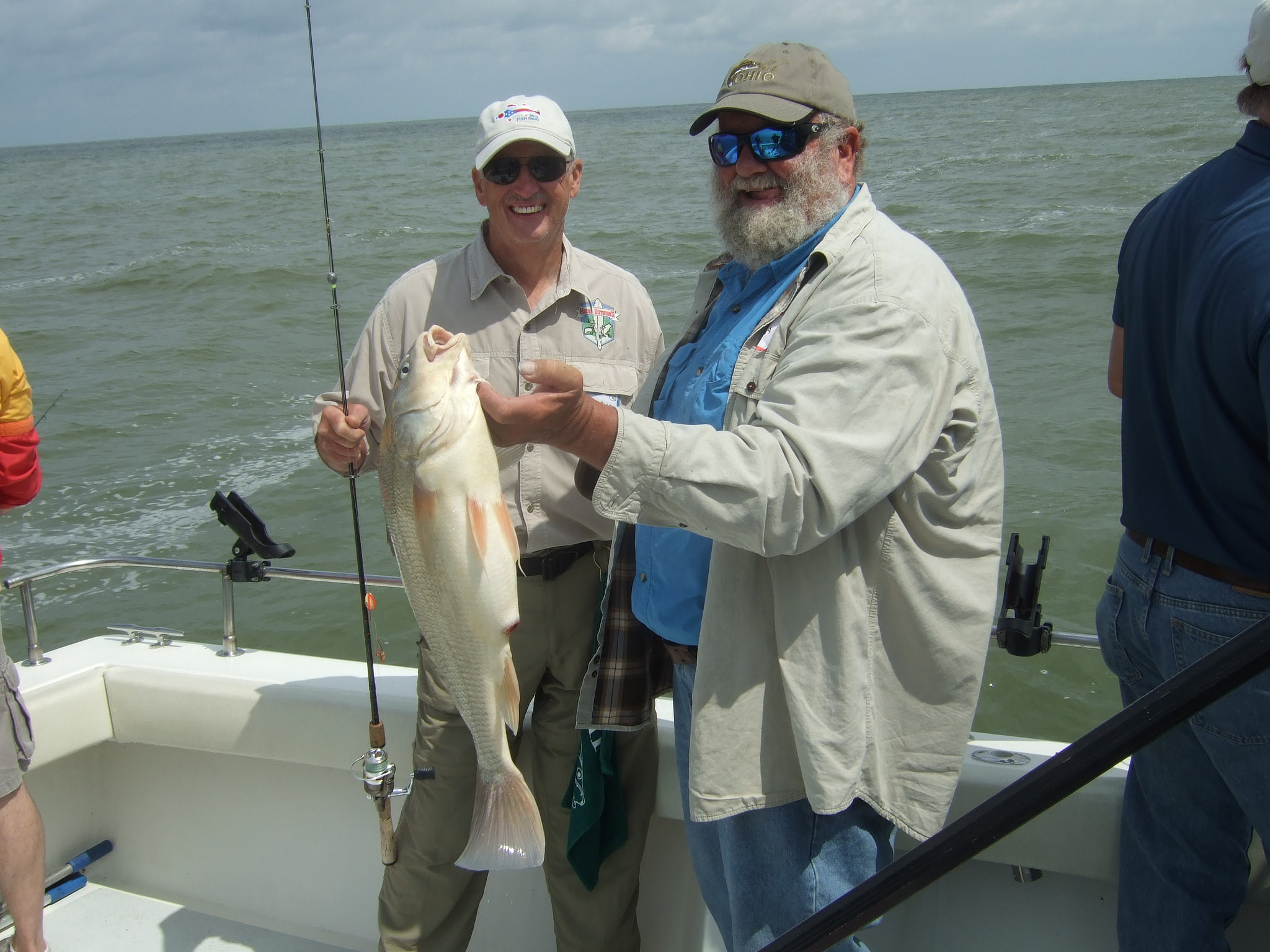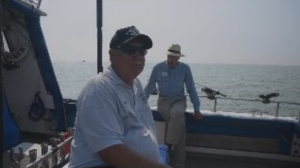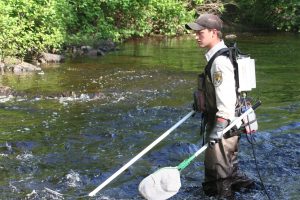
Fish Ohio Day on Lake Erie
Lake Erie means big water, big fish, big fun and big money. The 39th annual Governor’s Fish Ohio Day has morphed from a simple showcase of the state’s most abundant fishery to an education and networking event integral to the lake’s future wellness. Last year’s figures say there’s $15.1 billion in tourism-related economic impact for Ohio’s eight Lake Erie counties, $1.9 billion in tourism-related taxes and nearly 130,000 tourism-related jobs.
Historically, the event was held in July, however this year it was held August 14.

Charter Captain Don McGee, Photo by James Proffitt
“They want people to see the algae,” explained long-time charter captain Don McGee, who operates King & Eye Charters in eastern Lucas County. McGee spent the better part of a day with an Ohio Department of Natural Resources attorney, an Ohio Wildlife Council member, an ODNR fisheries manager and me. We sampled some of the best Fish Ohio fishing in recent memory. The Lake Erie Shores & Islands, Lake Erie Charter Boat Association, Ohio.org, the ODNR and its Division of Wildlife make the event happen with the generous donation of time, bait, fuel and expertise of the charter captains.
The outing gathers wildlife managers, scientists, wildlife law enforcement, media members and elected officials at all levels onto the decks of charter boats for angling and conversation. And if things work out, at the end of the day, guests are paired up with fresh Lake Erie fish.
McGee’s 30-foot Island Hopper was a perfect platform to check out the lake and its yellow perch a few miles west of the Toledo Water Intake. In 2014, the intake, situated about three miles offshore and a half dozen miles northeast of Toledo, was the site of a national news story when a toxic algal bloom shut the city’s drinking water supply down for several days.
“It’s like running through paint”
“If you look at the water right here,” McGee said, “you can see the algae.” McGee, who’s been a captain for decades, said algae is the biggest issue on the lake right now and has been for some years. “When it’s real thick, it clogs up an engine. It’s like running through paint.” And in addition to being a pain to run through, he said, it helps contribute to oxygen depletion in the water when it dies. When that happens, some fish leave, McGee said. Especially walleye, the most-prized sport fish on the lake. But in mid-August this year, the algae was only discernable to those who knew what to look for.
It wasn’t a thick, bright green, cartoonish soup.
This year, due to a dryer-than-average spring and early summer, the algae bloom, fed by phosphorous and other nutrients, is relatively mild so far. The algae appears as tiny green flecks in the water. But just because it’s not bad now doesn’t mean it won’t be in the future.
During the yellow perch trip, McGee produced a Secchi disc (courtesy of Angelo Secchi, Italian scientist, 1865) 12 inches round and divided into four quarters of black and white. “We provide data every Monday beginning in June and ending when I pull out of the lake,” McGee said.

Secchi disk being lowered into the water to measure water clarity, Photo by J. Albert Bowden II via flickr.com cc 2.0
He demonstrated how the disc is used to create science-based facts on water clarity, explaining the method as he lowered the disc into the water, then recorded the depth when those peering over the side could no longer see the disc. Charter captains like McGee also provide water samples to Ohio State University’s Stone Lab on Gibraltar Island throughout the season. Scientists began harvesting data from charter captains, who have a vested interest in the health of the lake, a few years back. And it works well. Captains send data in from completely random locations on the lake during the season and scientists use that data to work on solving the algae issue. McGee said that not only do Fish Ohio participants get to see what’s going on with the lake and its captains, but so do regular customers who are aboard when he and other captains perform data-collection tasks.
According to Brock Miskimen, chief legal counsel for ODNR, getting into the field is an integral component of his work. “It always helps to see in person what you’re working on,” he said, citing a recent visit to the Buckeye Lake, where dam and related construction issues have crossed paths with property encroachment issues. The August Fish Ohio trip was the first time Miskimen perch fished on Lake Erie. “It’s fun, this is really nice,” he explained. “And this is the first time I’ve had an opportunity to actually get out and see the algae. So it’s good. I’m seeing and learning something new out in the field.”
“A banner year for yellow perch and walleye”
Just before noon while anchored in about nine feet of water just north of Maumee Bay, McGee expounded on the algae and toxin issue. “You go to Maumee Bay, nobody’s in the water, nobody’s tubing or skiing. Just like today right here,” he said, glancing around. “It’s a beautiful day and I don’t see one recreational boater out here. Nobody’s out here.”

Backpack Electro-fishing, Photo by USFWS Midwest Region via flickr.com
The ODNR also hosted a science cruise, including hands-on electro-fishing and gill netting by outdoor writers. The techniques are commonly used to guestimate fish populations in a given area. Biologists and writers talked yellow perch and walleye management with fisheries managers. And of course, invasive species. “That’s always a concern,” said Eric Weimer, supervisor of the ODNR’s Sandusky Fisheries Unit. While invasive species are always on the radar right now, Weimer said, algae is the main issue. “On the flip side, we are having a banner year for yellow perch and walleye – especially in the Western Basin.”
In July, Ohio Gov. John Kasich signed an executive order requesting that eight Ohio watersheds be classified as distressed. The order instructs the Ohio Soil and Water Conservation Commission to review watersheds for the “distressed” designation, and the
ODNR, EPA, Ohio Department of Agriculture to recommend rules establishing nutrient management requirements for all farm nutrient sources. The distressed designation could be removed only after the director of agriculture determines the sustained recovery, restoration and mitigation of factors leading to the original designation.
This year, as is the same for the last several years, Kasich did not attend the event. Lt. Gov. Mary Taylor went fishing instead. “We have such a special natural resource and asset for the great state of Ohio in Lake Erie and I can’t think of a better way to be able to showcase how wonderful Lake Erie is,” she said. “The next generation and getting them engaged in this wonderful lake will, over time we hope, help make our job easier.”
After signing the order, Kasich also signed the Clean Lake 2020 Plan, unanimously approved by the Legislature. The plan allocates $36 million for farm-related conservation measures intended to improve water quality.
Great Lakes Now will look at those measures in future posts, and check back in with those who work on the lake and those who look to it for recreation.
Featured Image: 2015 Governor’s Fish Ohio Day, Photo by Jeff Reutter via flickr.com





